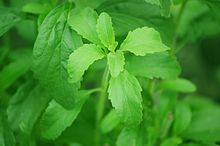
Back ستيفيا Arabic Stevia Azerbaijani استیویا AZB Stevia German Estevia (edulcorante) Spanish استیویا Persian Stevia Finnish स्टेविया Hindi സ്റ്റീവിയ Malayalam Stevia Malay
Stevia (/ˈstiːviə, ˈstɛviə/)[1][2] is a sweet sugar substitute that is about 50 to 300 times sweeter than sugar.[3] It is extracted from the leaves of Stevia rebaudiana, a plant native to areas of Paraguay and Brazil in the southern Amazon rainforest.[4] The active compounds in stevia are steviol glycosides (mainly stevioside and rebaudioside).[5]: 54 Stevia is heat-stable, pH-stable, and not fermentable.[6] Humans cannot metabolize the glycosides in stevia, and therefore it has zero calories. Its taste has a slower onset and longer duration than that of sugar, and at high concentrations some of its extracts may have an aftertaste described as licorice-like or bitter. Stevia is used in sugar- and calorie-reduced food and beverage products as an alternative for variants with sugar.[7]
The legal status of stevia as a food additive or dietary supplement varies from country to country. In the United States, certain high-purity stevia glycoside extracts have been generally recognized as safe (GRAS) and may be lawfully marketed and added to food products, but stevia leaf and crude extracts do not have GRAS or Food and Drug Administration (FDA) approval for use in food.[8] The European Union approved Stevia rebaudiana additives in 2011.[9] In Japan, stevia has been widely used as a sweetener for decades.[10]

The plant Stevia rebaudiana has been used for centuries by the Guaraní peoples of South America, who called it ka'a he'ê ("sweet herb").[11] The leaves have been used traditionally for hundreds of years in both Paraguay and Brazil to sweeten local teas, and as a "sweet treat".[11] The genus was named for the Spanish botanist and physician Pedro Jaime Esteve (Petrus James Stevus, 1500–1556) a professor of botany at the University of Valencia.[12]
- ^ "Stevia". Oxforddictionaries.com. British & World English. 7 February 2013. Archived from the original on 12 February 2013. Retrieved 13 February 2013.
- ^ "Stevia". Oxforddictionaries.com. US English. 7 February 2013. Archived from the original on 9 May 2013. Retrieved 13 February 2013.
- ^ Cardello, H.M.A.B.; da Silva, M.A.P.A.; Damasio, M.H. (1999). "Measurement of the relative sweetness of stevia extract, aspartame and cyclamate/saccharin blend as compared to sucrose at different concentrations". Plant Foods for Human Nutrition. 54 (2): 119–129. doi:10.1023/A:1008134420339. PMID 10646559. S2CID 38718610.
- ^ "Is Stevia A Good Sugar Substitute?". Doc Journals. 19 January 2021. Retrieved 27 January 2021.
- ^ Baines, J; et al. (Joint FAO/WHO Expert Committee on Food Additives) (2016). Evaluation of Certain Food Additives: Eighty-second report of the Joint FAO/WHO Expert Committee on Food Additives (PDF) (Technical report). WHO. ISBN 978-92-4-069586-3. 1000. Archived (PDF) from the original on 6 August 2022. Retrieved 10 December 2022.
- ^ Brandle, Jim (19 August 2004). FAQ – Stevia, Nature's Natural Low Calorie Sweetener (Report). Agriculture and Agri-Food Canada.
- ^ Samuel, Priscilla; Ayoob, Keith T; Magnuson, Bernadene A; Wölwer-Rieck, Ursula; Jeppesen, Per Bendix; Rogers, Peter J; Rowland, Ian; Mathews, Rebecca (1 July 2018). "Stevia Leaf to Stevia Sweetener: Exploring Its Science, Benefits, and Future Potential". The Journal of Nutrition. 148 (7): 1186S–1205S. doi:10.1093/jn/nxy102. hdl:1983/618532e2-6caa-4fbe-bd6e-6eb0cb608981. ISSN 0022-3166. PMID 29982648.
- ^ "Has stevia been approved by FDA to be used as a sweetener?". US Food and Drug Administration. 28 April 2017. Archived from the original on 29 July 2017. Retrieved 27 July 2017.
- ^ Stones, Mike (2011). "Stevia wins final EU approval". foodmanufacture.co.uk. Archived from the original on 18 November 2011. Retrieved 22 November 2011.
- ^ "Stevia herb shakes up global sweetener market". The Independent. 28 March 2010. Archived from the original on 28 July 2017. Retrieved 13 July 2017.
- ^ a b Misra, H.; Soni, M.; Silawat, N.; Mehta, D.; Mehta, B.K.; Jain, D.C. (April 2011). "Antidiabetic activity of medium-polar extract from the leaves of Stevia rebaudiana Bert. (Bertoni) on alloxan-induced diabetic rats". J Pharm Bioallied Sci. 3 (2): 242–248. doi:10.4103/0975-7406.80779. PMC 3103919. PMID 21687353.
- ^ Parsons, W.T.; Cuthbertson, E.G. (2001). Noxious Weeds of Australia, 2nd ed. Collingswood, Australia: CSIRO Publishing. p. 309. ISBN 978-0-643-06514-7. Specifically, this reference refers to Stevia eupatoria, a related weed with a similar name-origin.
© MMXXIII Rich X Search. We shall prevail. All rights reserved. Rich X Search